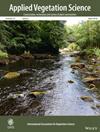New and Overlooked Syntaxa of European Vegetation and Their Accumulation Over Time
Abstract
Aims
Since the publication of the first comprehensive classification system of European vegetation (EuroVegChecklist) by Mucina and collaborators in 2016, many new high-rank syntaxa (classes, orders, and alliances) have been published across Europe. However, only a few of them have been included in the updated versions of the EuroVegChecklist so far. Here, we (1) review the new high-rank syntaxa published from Europe in the period 2017–2022 or before 2017 but not included in the EuroVegChecklist and (2) describe the temporal dynamics of publishing new high-rank syntaxa of European vegetation since the beginning of the Braun-Blanquet school in the early 20th century.
Location
Europe.
Methods
We searched for new descriptions of high-rank syntaxa from Europe by systematically reviewing the 2016 to 2022 volumes of 21 journals that regularly publish such descriptions. We also included syntaxa that were not listed in the EuroVegChecklist but were found through our additional non-systematic searches. We summarised the information on these syntaxa in a database and analyzed the frequency of descriptions of new syntaxa before and after the publication of the EuroVegChecklist.
Results
New syntaxa have been continually described for more than a century. There were several waves of new syntaxon descriptions, but no decrease in such descriptions after the EuroVegChecklist was published. We found 342 high-rank syntaxa (275 alliances, 48 orders and 19 classes) not included in the EuroVegChecklist, of which 69 were published before the EuroVegChecklist and 273 between 2017 and 2022. However, many of them were not described validly according to the International Code of Phytosociological Nomenclature. Most of the new high-rank syntaxa were described both in the countries with well-studied vegetation (e.g., France, Italy, Spain) and in the countries with suspected gaps in vegetation research (e.g., Russia, Ukraine, Greece, Georgia).
Conclusions
As most of the newly described syntaxa have not been submitted to the European Vegetation Classification Committee for consideration, our list represents a source of information for vegetation scientists that complements the EuroVegChecklist and may serve as a basis for its future updates.


 求助内容:
求助内容: 应助结果提醒方式:
应助结果提醒方式:


